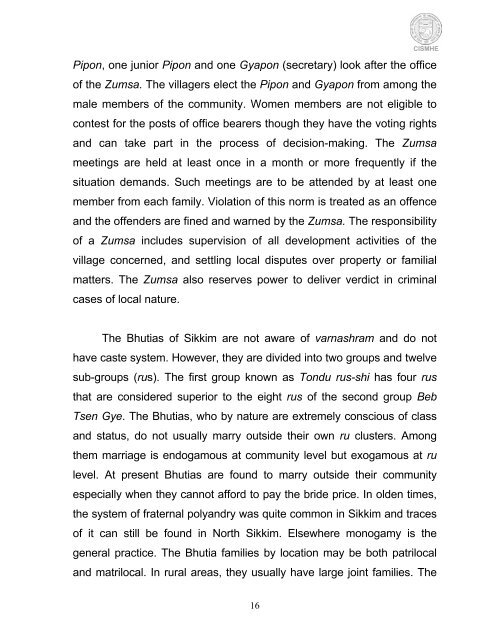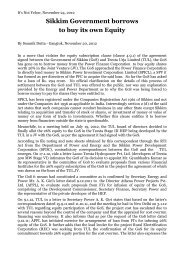Socio-Cultural Environment - Affected Citizens of Teesta (ACT)
Socio-Cultural Environment - Affected Citizens of Teesta (ACT)
Socio-Cultural Environment - Affected Citizens of Teesta (ACT)
Create successful ePaper yourself
Turn your PDF publications into a flip-book with our unique Google optimized e-Paper software.
16<br />
CISMHE<br />
Pipon, one junior Pipon and one Gyapon (secretary) look after the <strong>of</strong>fice<br />
<strong>of</strong> the Zumsa. The villagers elect the Pipon and Gyapon from among the<br />
male members <strong>of</strong> the community. Women members are not eligible to<br />
contest for the posts <strong>of</strong> <strong>of</strong>fice bearers though they have the voting rights<br />
and can take part in the process <strong>of</strong> decision-making. The Zumsa<br />
meetings are held at least once in a month or more frequently if the<br />
situation demands. Such meetings are to be attended by at least one<br />
member from each family. Violation <strong>of</strong> this norm is treated as an <strong>of</strong>fence<br />
and the <strong>of</strong>fenders are fined and warned by the Zumsa. The responsibility<br />
<strong>of</strong> a Zumsa includes supervision <strong>of</strong> all development activities <strong>of</strong> the<br />
village concerned, and settling local disputes over property or familial<br />
matters. The Zumsa also reserves power to deliver verdict in criminal<br />
cases <strong>of</strong> local nature.<br />
The Bhutias <strong>of</strong> Sikkim are not aware <strong>of</strong> varnashram and do not<br />
have caste system. However, they are divided into two groups and twelve<br />
sub-groups (rus). The first group known as Tondu rus-shi has four rus<br />
that are considered superior to the eight rus <strong>of</strong> the second group Beb<br />
Tsen Gye. The Bhutias, who by nature are extremely conscious <strong>of</strong> class<br />
and status, do not usually marry outside their own ru clusters. Among<br />
them marriage is endogamous at community level but exogamous at ru<br />
level. At present Bhutias are found to marry outside their community<br />
especially when they cannot afford to pay the bride price. In olden times,<br />
the system <strong>of</strong> fraternal polyandry was quite common in Sikkim and traces<br />
<strong>of</strong> it can still be found in North Sikkim. Elsewhere monogamy is the<br />
general practice. The Bhutia families by location may be both patrilocal<br />
and matrilocal. In rural areas, they usually have large joint families. The




